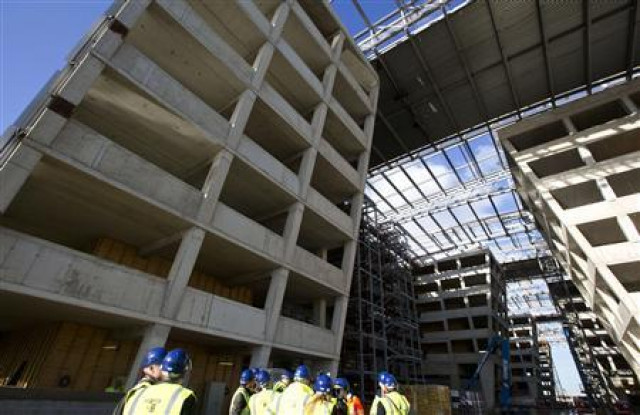NATO builds $1 billion HQ as allies cut military spending
More than 4,000 NATO staff and diplomats from the 28 allies and 22 partner countries are to move in 2016.

Exterior view of the new NATO headquarters, currently under construction in Brussels November 13, 2013. PHOTO: REUTERS/FILE
The vast steel-and-glass structure is taking shape in the outskirts of Brussels, across the road from the old headquarters, built as a temporary home for the alliance in 1967 and which NATO officials say has outlived its useful life.
Construction is 80 percent complete on the new building, made up of eight curving wings that connect to a huge central space with an imposing 32 meter (yard)-high entrance.
More than 4,000 NATO staff and diplomats from the 28 allies and 22 partner countries are to move in 2016.
NATO members have shared the cost of the new headquarters at a time when many are being forced to cut key military capabilities due to a budget squeeze.
NATO also faces questions about its future after it ends combat operations in Afghanistan at the end of next year.
"When defense budgets are being cut and in general when governments are under so much pressure from taxpayers to save money, it looks terribly extravagant," said Daniel Keohane, head of strategic affairs at the FRIDE think tank in Brussels.
NATO leaders gave the go-ahead for a new headquarters in 1999, long before the financial crisis broke. But the timing of the construction of the eight-floor structure, including enough blast-resistant glass to cover 10 football pitches, was "unfortunate", Keohane said.
Several British legislators have been quoted in the media as questioning the cost.
21st century
Matthew Klimow, a NATO deputy assistant secretary-general, said the new headquarters was "far from extravagant".
"It is a functional building that will allow us to say to the world that NATO is ready for 21st-century challenges," he told Reuters during a media tour of the new headquarters.
Klimow said the current NATO headquarters was designed to last for only 10 years when it opened in 1967.
Portable buildings were installed to house extra staff as the alliance grew from 15 nations in 1967 to 28 today.
Electrical systems are archaic, concrete floors crumbling and the grounds teeming with stray cats and rabbits which burrow under the foundations, officials say.
The new headquarters will be environmentally friendly and have advanced communications and security, they say. It is being built near the site of a World War Two German airfield and construction was delayed for months after two unexploded bombs were found.
Formed in 1949 in response to the threat posed by the Soviet Union, NATO transformed itself after the Cold War, taking in a number of eastern European countries and leading international forces in Afghanistan over the last decade.
With its combat mission there drawing to an end, the alliance is again at a crossroads, with little appetite among war-weary allies to take on major new military commitments.
The alliance leads some 5,000 soldiers in Kosovo, a counter-piracy mission in the Indian Ocean and will keep a smaller training mission in Afghanistan from 2015.
NATO spokeswoman Oana Lungescu said building the new headquarters was "a vote of confidence in the future of NATO".
"How long in history have we been without a job, across the decades? Our job is to be ready in case we are called to do it," NATO's military chief, U.S. Air Force General Philip Breedlove, said during a NATO exercise in Poland last week.














COMMENTS
Comments are moderated and generally will be posted if they are on-topic and not abusive.
For more information, please see our Comments FAQ